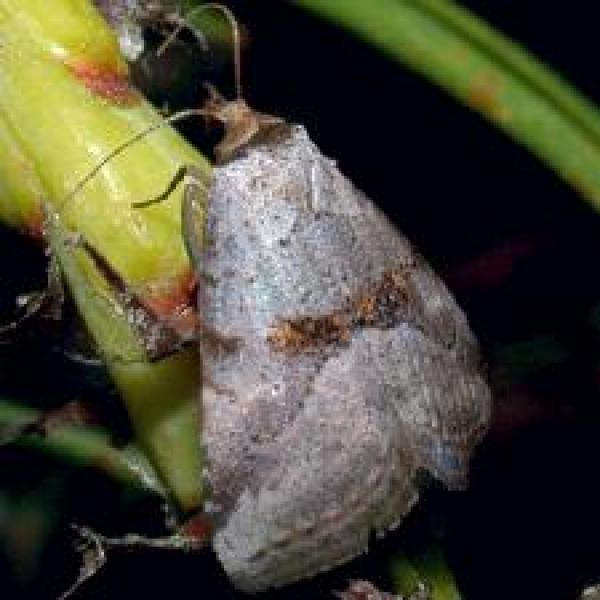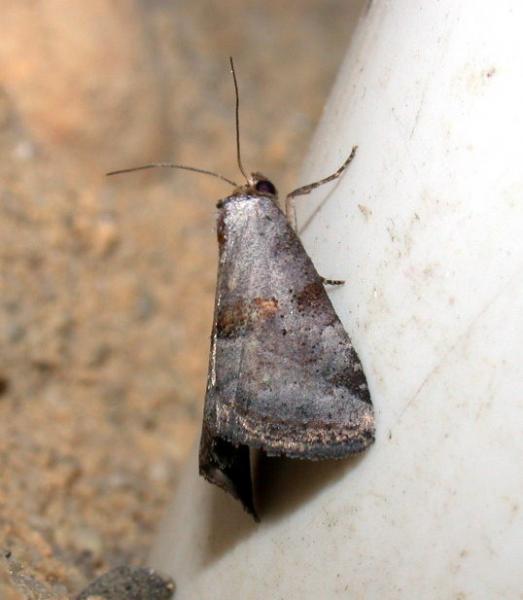Yellow-spotted Graylet
Hyperstrotia flaviguttata (Grote, 1882)
- Class
- Insecta (Insects)
- Family
- Erebidae
- State Protection
- Not Listed
Not listed or protected by New York State.
- Federal Protection
- Not Listed
- State Conservation Status Rank
- SU
Unrankable - Currently unrankable due to lack of information or due to substantially conflicting information about status or trends.
- Global Conservation Status Rank
- G4
Apparently Secure globally - Uncommon in the world but not rare; usually widespread, but may be rare in some parts of its range; possibly some cause for long-term concern due to declines or other factors.
Summary
Did you know?
This species is a member of the Owlet Moth family. These moths typically fly at night and some are preyed upon by bats. Many Owlet Moths have tiny organs in their ears that sense bat echolocation calls. The signal from these organs causes their wing muscles to spasm and they dart erratically. This aids the moths in evading the bats (Fullard 1998).
State Ranking Justification
This species has only been found in one location in New York State. Since 1999, it has been recorded on a regular basis from the dwarf pine barrens of Long Island. There is one historical record from Orange County, New York, but it has never been relocated there. Future surveys in areas of pine and scrub oak habitat may find additional occurrences of this species.
Short-term Trends
The presence of this species over multiple years at the dwarf pine barrens site on Long Island indicates that the population is viable and is reproducing. Surveys since 1996 have indicated very little change in the population. Forest fires in the dwarf pine plains, especially the very large forest fire in 1995, resulted in an increase in habitat for this species.
Long-term Trends
The long-term trend for this species is tied to the long-term trend of the natural community it lives in. The acreage of dwarf pine plains in New York has declined due to development, although there is still a large occurrence of this habitat type on Long Island.
Conservation and Management
Threats
Known threats include habitat loss due to development and fire suppression, although the threat of development for the remaining habitat on Long Island may be low. The suppression of fires in barrens and other dry places would cause a loss of habitat for the species and therefore a reduction in population size. This species requires open woodland or barrens with pitch pine and especially scrub oaks (food source). Forest fires are needed, on average, every 5-10 years (Jordan et al. 2003) to maintain this type of habitat. Lack of fires will result in the succession of this community to a closed-canopy forest of tall oaks and other hardwoods (Little 1979, Jordan et al. 2003). Conversely, a fire affecting an entire occurrence could eliminate all life stages that are present.
Conservation Strategies and Management Practices
The best management strategy for this species is the management of the natural community, or habitat, where this species occurs. Maintaining the Long Island pine barrens with their full suite of plant and animal species requires frequent (every few decades) disturbance to maintain open-canopy, shrub-dominated communities and to prevent succession to a closed-canopy hardwood forest (Jordan et al. 2003). Researchers have determined that "an active fire management program utilizing prescribed fire with appropriate mechanical treatments" is the preferred method (Jordan et al. 2003). Researchers have also determined that the size, type, intensity, and timing of fires (pyrodiversity) needs to be evaluated for each site to maximize benefits to the natural community and the species it supports (Jordan et al. 2003). The entire occupied habitat for a population should not be burned in a single year. For example, in places where prescribed burning is used, refugia (unburned areas) are needed for many species to ensure that any life stage can survive a fire.
Research Needs
Additional surveys are needed with blacklight traps to determine the extent of the occurrence. In addition, research is needed on the response of this species to prescribed (controlled) burning and mechanical treatment to improve habitat.
Habitat
Habitat
In New York State, the Yellow-spotted Graylet is found only in the dwarf pine barrens on Long Island. These open, dry woodlands are dominated by a mixture of dwarf pitch pine and scrub oak. Scrub oak is the food source for the caterpillar.
Associated Ecological Communities
- Dwarf pine plains
(guide)
A woodland community dominated by dwarf individuals of pitch pine and scrub oak that occurs on nearly level outwash sand and gravel plains in eastern Long Island. The soils are infertile, coarse textured sands that are excessively well-drained.
Associated Species
- Burgess's Apamea (Apamea burgessi) (guide)
- Herodias Underwing (Catocala herodias)
- Jair Underwing (Catocala jair)
- Melsheimer's Sack Bearer (Cicinnus melsheimeri) (guide)
- Packard's Lichen Moth (Cisthene packardii) (guide)
- Projecta Gray (Cleora projecta) (guide)
- Pine Tussock Moth (Dasychira pinicola) (guide)
- A Geometrid Moth (Euchlaena madusaria) (guide)
- Fringed Dart (Eucoptocnemis fimbriaris) (guide)
- Violet Dart (Euxoa violaris) (guide)
- Coastal Barrens Buckmoth (Hemileuca maia ssp. 5) (guide)
- Pale Green Pinion Moth (Lithophane viridipallens) (guide)
- Pin-striped Slug Moth (Monoleuca semifascia) (guide)
- Gray Woodgrain (Morrisonia mucens) (guide)
- Pink Sallow (Psectraglaea carnosa) (guide)
- Spinose Flower Moth (Schinia spinosae) (guide)
- Barrens Itame (Speranza exonerata) (guide)
- Gordian Sphinx (Sphinx gordius) (guide)
- Toothed Apharetra (Sympistis dentata) (guide)
- Orange Holomelina (Virbia aurantiaca) (guide)
- Pine Barrens Zale (Zale lunifera) (guide)
Range
New York State Distribution
This species may be confined to Long Island in New York.
Global Distribution
The Yellow-spotted Graylet is ranked S4S5 in New Jersey. It is more rare in Pennsylvania, and the status is unknown in Connecticut. This species is fairly common south of New Jersey. North of New Jersey, it has been seen only in scrub oak areas of Massachusetts and New York (Schweitzer 1997). It was recorded historically from New Windsor, Orange County, New York (Forbes 1954).
Best Places to See
- Dwarf pine barrrens (Suffolk County)
Identification Comments
Identifying Characteristics
This species can be identified from a specimen or a good image. This moth is violet-gray with some light brown shading. Look for a small yellow spot above a brown median patch (Covell 1984).
Best Time to See
The adult moths of this species are active throughout the summer months.
- Present
- Reproducing
The time of year you would expect to find Yellow-spotted Graylet present and reproducing in New York.
Yellow-spotted Graylet Images
Taxonomy
Yellow-spotted Graylet
Hyperstrotia flaviguttata (Grote, 1882)
- Kingdom Animalia
- Phylum Arthropoda
(Mandibulates)
- Class Insecta
(Insects)
- Order Lepidoptera
(Butterflies, Skippers, and Moths)
- Family Erebidae
- Order Lepidoptera
(Butterflies, Skippers, and Moths)
- Class Insecta
(Insects)
- Phylum Arthropoda
(Mandibulates)
Additional Resources
References
Blanchard, Orland J. 1996. Field survey to Dwarf Pine Barrens of August 18, 1996.
Covell, Charles V. 1984. A field guide to the moths of eastern North America. Houghton Mifflin Company, Boston.
Forbes, William T. M. 1954. Lepidoptera of New York and neighboring states part III. Cornell University Experiment Station Memoir 329.
Fullard, J.H. 1998. The sensory coevolution of moths and bats. Pages 279-326 in: Comparative hearing: insects (ed R.R. Hoy, A.N. Popper and R.R. Fay). Springer, Berlin.
Holland, W.J. 1968. The moth book. Dover Publications, NY, 479 pp. An unabridged version first published in 1903 by Doubleday, Page, and Co.
Jordan, M. J., W. A. Patterson III, A. G. Windisch. 2003. Conceptual ecological models for the Long Island pitch pine barrens: implications for managing rare plant communities. Forest Ecology and Management 185, 151-168.
Little, S. 1979. Fire and plant succession in the New Jersey pine barrens. pp. 297-313 in Forman, R.T.T. (ed.) Pine Barrens: Ecosystem and Landscape. Academic Press, Inc. Orlando, FL.
McGuinness, Hugh D. 2009. Moths of fire: a study of the macro-lepidoptera in burned and unburned plots at the New York State Department of Environmental Conservation's Sarnoff Preserve in Flanders, Suffolk County, New York. 2006-2008. Report for the Long Island Chapter of The Nature Conservancy.
McGuinness, Hugh. 2006. Overview of the 2005 Dwarf Pine Plains data.
NatureServe. 2010. NatureServe Explorer: An online encyclopedia of life [web application]. Version 7.1. NatureServe, Arlington, Virginia. Available http://www.natureserve.org/explorer. (Data last updated August 2010)
New York Natural Heritage Program. 2024. New York Natural Heritage Program Databases. Albany, NY.
Wagner, D.L. 2005. Caterpillars of Eastern North America. Princeton Field Guides. Princeton University Press, Princeton NJ. 512 pp.
Links
About This Guide
This guide was authored by: Lauren Lyons-Swift
Information for this guide was last updated on: December 17, 2011
Please cite this page as:
New York Natural Heritage Program. 2024.
Online Conservation Guide for
Hyperstrotia flaviguttata.
Available from: https://guides.nynhp.org/yellow-spotted-graylet/.
Accessed July 26, 2024.

